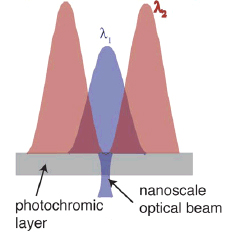Wednesday, April 22nd, 2009
Researchers at MIT have demonstrated deep subwavelength lithography using a photochromic contrast enhancing layer, as reported in SciencExpress April 9. A thin photochromic film on top of a conventional photoresist layer was exposed to two wavelengths of light with two distinct patterns. One wavelength exposed the photoresist while the other made the photochromic film opaque to that wavelength, without exposing the resist itself. These results demonstrate the feasibility of litho-litho-etch double-patterning (LLE-DP).

When illuminated with a node at Lambda2 coincident with a peak at Lambda1, an aperture is formed to reach the underlying photoresist. (source: MIT)
The molecules chosen to comprise the photochromic film adopt two isomeric forms that interconvert reversibly on respective absorption of light at ultraviolet (Lambda1) and visible (Lambda2) wavelengths. Sub-wavelength patterns result from applying both colors in an interference pattern that overlaps peaks at Lambda1 with nodes at Lambda2. Absorption at Lambda1 generates the isomer transparent at that wavelength, but regions exposed to Lambda2 revert to the initial isomer and continue to absorb at Lambda1, protecting the photoresist. Only at the Lambda2 nodes does a stable, transparent aperture form (see figure).
Photons at Lambda1 penetrate this aperture, forming a nanoscale writing beam that can pattern the underlying photoresist. The aperture size decreases as the ratio of the intensity at Lambda2 to that at Lambda1 increases. Because there is no wavelength of darkness to limit the width of this node, this absorbance modulation can confine light to spatial dimensions far smaller than the wavelength of light. The pitch, however, is limited by Lambda2. More on this in the BetaSights Newsletter. –M.D.L.
